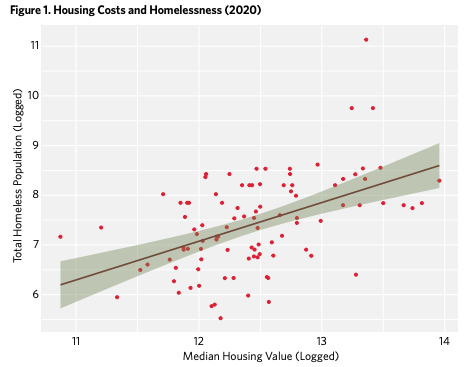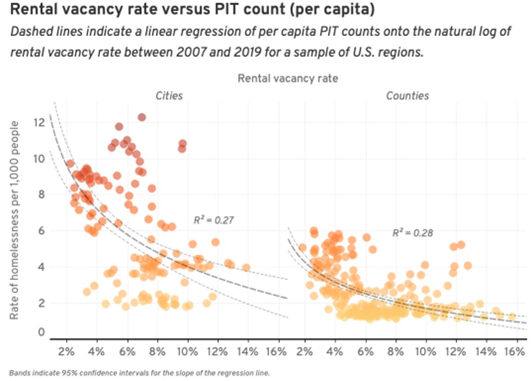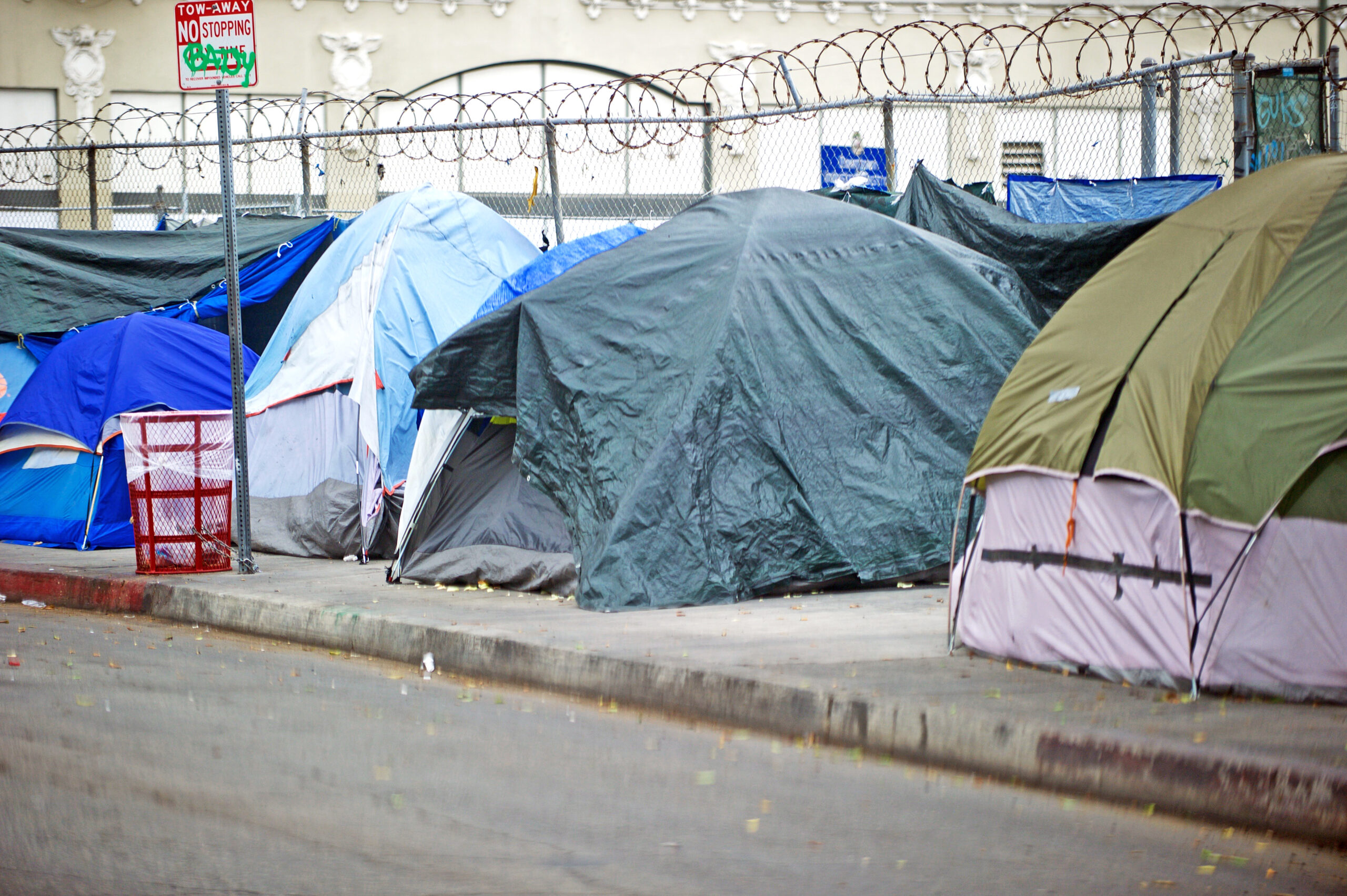Reading time: 7 minutes
In the United States, one of the leading drivers of homelessness is a lack of access to affordable housing.
Since 2008, the United States has experienced both an underproduction of new housing being built and a trend of deregulation of existing affordable housing. Demand for housing has outpaced supply, driving up housing costs and leaving a dearth of affordable housing units.
Exclusionary zoning laws and land use regulations have played critical roles in limiting new housing development. Other factors have included high land and development costs and the need for more developable properties.
This piece will define land use regulations and zoning ordinances. It will describe the roles that cities, counties, and states can play in adapting or implementing policies to lower housing costs and boost the affordable housing supply for low-income households.

Source: Einstein, Katherine Levine & Willison, Charley E. (2023). Policy Brief: Cities, Zoning, and the Fragmented Response to Homelessness. Boston University Initiative on Cities, Cornell University, and Community Solutions.

Source: Colburn, Gregg & Aldern, Clayton Page. (2022). Homelessness Is a Housing Problem: How Structural Factors Explain U.S. Patterns. University of California Press. 133. https://homelessnesshousingproblem.com/
Land regulations and zoning ordinances
Land use regulations and zoning ordinances are two key policies that can suppress the supply of affordable rental housing units in the United States.
Through land use regulations, municipalities decide how land within its jurisdiction is used for, determining the plan and use of land for things like parks, residential housing, manufacturing, and commercial purposes.
By weighing various public benefits when considering possible development uses, these decisions impact how much housing can be built and where while. Outdated land use regulations and exclusionary zoning laws restrict the number and typologies of homes that can be developed in specific neighborhoods, ultimately suppressing the housing supply.
Local government entities use zoning ordinances to determine what types of development can be built on a parcel of land and to set limits on how a property owner can use that land.
For example, single-family zoning, which designates that a lot can only accommodate a single dwelling for one household, has stifled the supply of affordable housing by preventing the construction of multi-family developments that have higher density and that provide homes to more households on a single lot. Not only does single-family zoning restrict the supply of affordable housing, but it is also a tactic used to perpetuate housing segregation.
The impact on low-income households
Within the United States, extremely low-income households are impacted most acutely by the lack of affordable housing. As mentioned above, land use regulations and zoning ordinances constrain the supply of affordable housing, making existing housing more scarce and expensive.
Households that have the fewest financial resources, such as those experiencing or at risk of homelessness and those earning less than 30% AMI or having an income at or below the federal poverty line, have the least amount of housing available to them that they can rent at an affordable rate.
In recent years, the lack of housing affordable to low-income renters has only grown along with the number of low-income households. Between 2019 and 2021, the shortage of affordable housing stock increased by more than 500,000 rental homes while the number of renters with extremely low incomes increased. Therefore, the supply of housing affordable to those households decreased. With fewer affordable homes and more low-income individuals, extremely low-income renters have few options when trying to secure a place to call home.
The role of cities, counties, and states
Cities, counties, and states have the authority to implement zoning and land use policies that help lower housing costs and boost the supply of housing affordable to low-income households. Local and state policymakers can increase the supply of housing affordable to extremely low-income renters and reduce homelessness by implementing land use and zoning policies, such as:
- Eliminating exclusionary zoning codes that restrict multi-family use, such as single-family zoning
- Legalizing accessory dwelling units (ADUs) and basement/cellar units
- Removing minimum lot-size requirement ordinances
- Revising minimum building size and floor area ratio requirements
- Eliminating parking requirements for new residential construction projects
- Allowing for development using manufactured housing
- Revising building codes that restrict low-cost rental housing development
- Simplifying the housing permitting and development process
- Creating financial and development incentives that promote the creation of affordable housing
- Approving housing development near public transportation and central business districts
- Removing barriers to developing mixed-use residential and commercial developments
- Promoting high-density infill development
- Prioritizing affordable housing development when disposing of public land (footnote 15).
Cities, counties, and states have changed land use and zoning policies to expand housing stock and promote greater affordability. For example:
- In 2021, the state of California passed legislation that banned single-family-only zoning statewide. The legislation essentially legalized duplex housing, which helped accelerate the ability to build more affordable housing in the state.
- Portland, Oregon, changed its zoning code in 2021 to be the first city in the United States that allows two accessory dwelling units (ADUs) on any property in any configuration. As part of the 2021 zoning code amendments, Portland also eliminated parking requirements for residential developments, allowed for detached ADUs on properties with duplexes, and increased the maximum size allowable for a basement apartment.
- Austin, Texas, amended a city zoning ordinance regarding the minimum lot area requirement for some single-family housing and reduced the minimum off-street parking requirement to one space per four units in order to spur multi-family developments in the city. In addition to the lot coverage and parking changes, Austin included affordability requirements as part of the zoning ordinance amendments, with at least 10 percent of rental units being reserved for at least 40 years for households earning up to 50 percent of the area median income.
- Sacramento, California, has proactively implemented new business processes to expedite the City’s approval and permitting process for development. The Sacramento Community Development Department’s Building Division offers an Over the Counter (OTC) Plan Review for residential and commercial projects to speed up the building review process.
- In 2016, the New York City Council amended the municipal zoning code to create the Mandatory Inclusionary Housing Program. This incentive program offered increased buildable zoning density to residential construction projects that create new set-aside affordable housing units.
Other Sources
Colburn, Gregg and Aldern Clayton Page. (2022). Homelessness Is a Housing Problem: How Structural Factors Explain U.S. Patterns. University of California Press. https://homelessnesshousingproblem.com/
Footnote 15: Schuetz, Jenny. (2022). Fixer-Upper: How to Repair America’s Broken Housing Systems. Brookings Institution Press.
